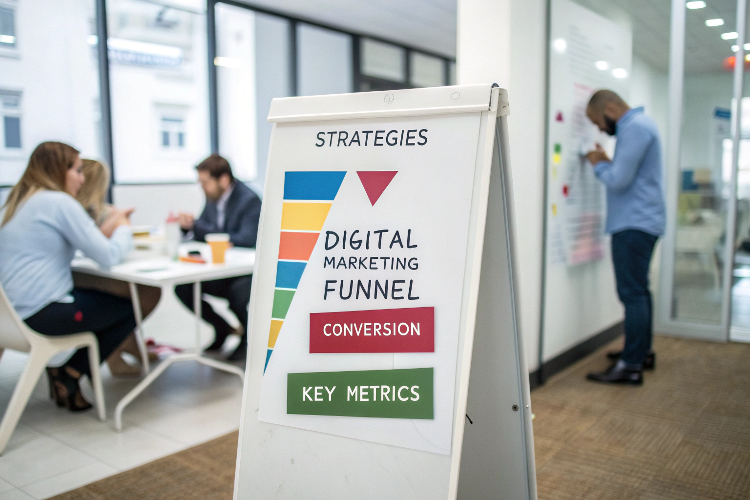Blog
How to Create a Digital Marketing Funnel That Converts ?
Digital Marketing & Branding ▪ 2025-03-10

A well-structured digital marketing funnel is essential for converting website visitors into loyal customers. The funnel guides potential customers through the buyer’s journey, from initial awareness to final conversion. If properly optimized, a marketing funnel can significantly improve lead generation, customer engagement, and sales growth.
In this guide, we’ll break down the key stages of a digital marketing funnel, provide actionable strategies for optimizing each stage, and discuss how to improve conversions effectively.
What is a Digital Marketing Funnel?
A digital marketing funnel is a step-by-step framework that maps the customer journey from discovery to conversion. It consists of different stages designed to move potential buyers closer to making a purchase.
Key Stages of a Digital Marketing Funnel:
-
Awareness - Attract potential customers and introduce them to your brand.
-
Interest - Engage and educate users about your product or service.
-
Consideration - Nurture leads and build trust through valuable content.
-
Conversion - Encourage prospects to take the desired action (purchase, sign-up, or inquiry).
-
Loyalty & Advocacy - Retain customers and turn them into brand ambassadors.
Each stage requires a unique marketing strategy to maximize conversions and build long-term customer relationships.
Step 1: Creating Awareness (Top of the Funnel - TOFU)
At the top of the funnel, the goal is to attract potential customers who may not yet be familiar with your brand. The focus is on increasing visibility and driving traffic.
Strategies to Increase Awareness:
-
Search Engine Optimization (SEO): Optimize content to rank higher in search engine results.
-
Content Marketing: Publish informative blog posts, infographics, and videos.
-
Social Media Marketing: Engage users on platforms like Facebook, Instagram, LinkedIn, and Twitter.
-
Pay-Per-Click (PPC) Advertising: Run Google Ads and social media ads to reach target audiences.
-
Influencer Marketing: Collaborate with influencers to expand brand reach.
Key Metrics to Track:
-
Website traffic and page views.
-
Social media engagement (likes, shares, comments).
-
Click-through rates (CTR) on ads.
Step 2: Generating Interest (Middle of the Funnel - MOFU)
Once you’ve captured the audience’s attention, the next step is to nurture their interest by providing valuable information and building trust.
Ways to Engage & Educate Prospects:
-
Lead Magnets: Offer free resources (eBooks, whitepapers, checklists) in exchange for email sign-ups.
-
Webinars & Live Events: Host interactive sessions to showcase expertise.
-
Email Marketing Campaigns: Send personalized newsletters with relevant content.
-
Case Studies & Testimonials: Highlight success stories to build credibility.
-
Retargeting Ads: Show targeted ads to users who previously visited your site.
Key Metrics to Track:
-
Email open and click-through rates.
-
Time spent on key pages.
-
Conversion rate of lead magnets.
Step 3: Encouraging Consideration (Middle of the Funnel - MOFU)
At this stage, potential customers are evaluating different options and deciding whether your product or service meets their needs.
Strategies to Build Trust & Persuade Buyers:
-
Product Demonstrations & Tutorials: Showcase the benefits of your offering.
-
Personalized Email Sequences: Send targeted follow-up emails based on user behavior.
-
Comparison Guides: Provide comparisons with competitors to highlight advantages.
-
Social Proof & User-Generated Content: Feature customer reviews and testimonials.
-
Limited-Time Offers & Discounts: Create urgency with special promotions.
Key Metrics to Track:
-
Engagement with educational content.
-
Number of product demo sign-ups.
-
Lead-to-customer conversion rates.
Step 4: Driving Conversions (Bottom of the Funnel - BOFU)
This is the most crucial stage where you turn leads into paying customers. A seamless checkout or sign-up experience is key to maximizing conversions.
Strategies to Optimize Conversions:
-
Clear Call-to-Actions (CTAs): Ensure CTAs are prominent and compelling.
-
Optimized Landing Pages: Design high-converting pages with persuasive copy.
-
Simplified Checkout Process: Minimize form fields and offer multiple payment options.
-
Chatbots & Live Chat Support: Provide real-time assistance to answer queries.
-
Money-Back Guarantees: Reduce hesitation with risk-free offers.
Key Metrics to Track:
-
Conversion rate on sales or sign-ups.
-
Cart abandonment rate.
-
Average order value (AOV).
Step 5: Customer Retention & Advocacy (Beyond the Funnel)
The marketing funnel doesn’t end at conversion. Retaining customers and turning them into loyal advocates is just as important.
Strategies to Build Customer Loyalty:
-
Loyalty Programs: Reward repeat customers with discounts and perks.
-
Follow-Up Emails: Send thank-you messages and exclusive offers.
-
Community Engagement: Create a customer community for interaction.
-
Referral Programs: Incentivize referrals to attract new customers.
-
Surveys & Feedback Requests: Improve products and services based on user feedback.
Key Metrics to Track:
-
Customer retention rate.
-
Net Promoter Score (NPS).
-
Number of referrals and repeat purchases.
Optimizing Your Digital Marketing Funnel for Better Conversions
Even the best funnels require continuous optimization to improve performance. Here’s how to refine your funnel:
1. Conduct A/B Testing
-
Test different versions of headlines, CTAs, landing pages, and email subject lines.
-
Analyze which variations yield higher conversions.
2. Use Analytics & Heatmaps
-
Track user behavior using Google Analytics, Hotjar, and other tools.
-
Identify drop-off points and optimize accordingly.
3. Personalize the Customer Journey
-
Use AI-driven insights to deliver personalized recommendations.
-
Segment audiences based on behavior, demographics, and interests.
4. Automate Marketing Processes
-
Leverage automation tools for email sequences, lead nurturing, and retargeting.
-
Use AI-powered chatbots for instant customer engagement.

